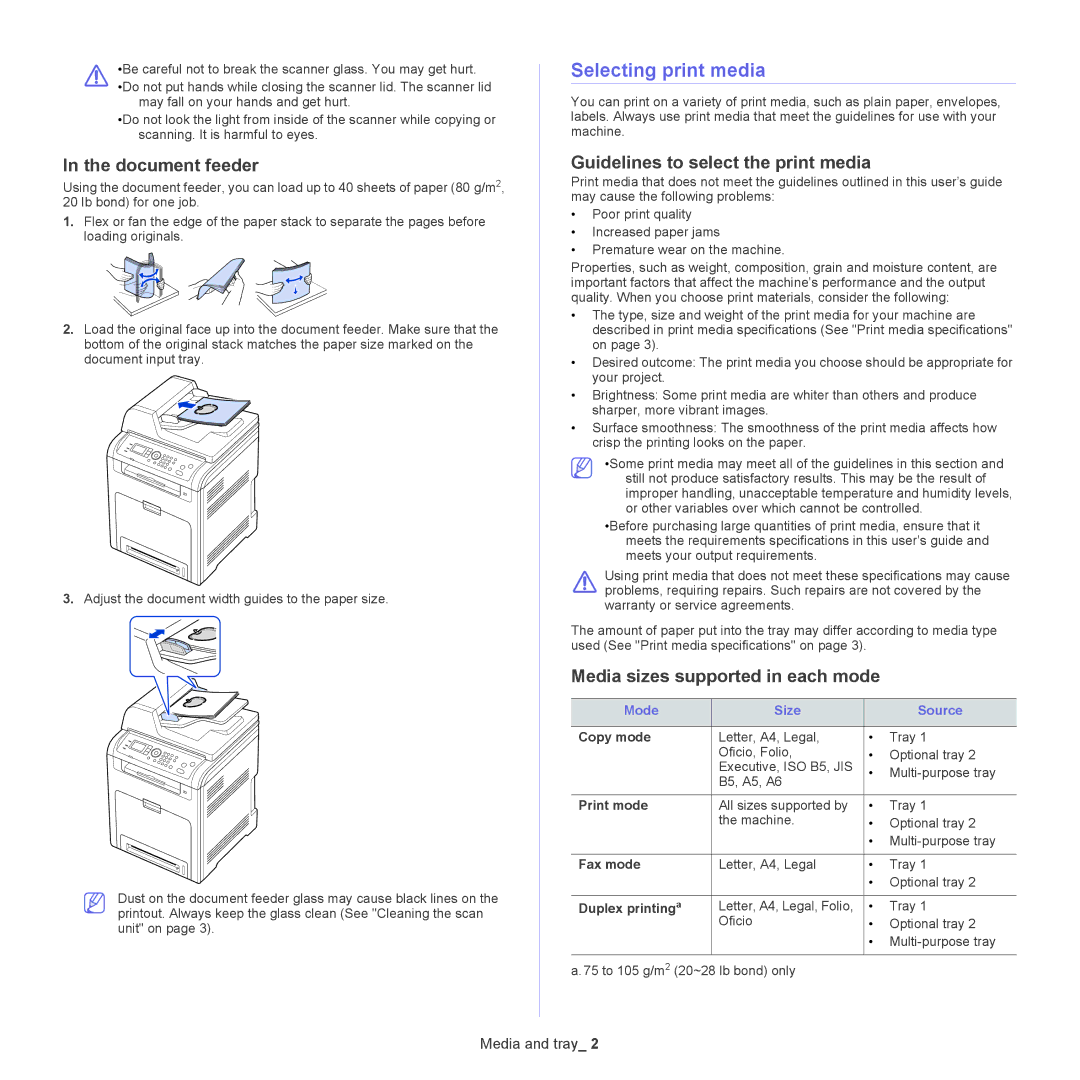
•Be careful not to break the scanner glass. You may get hurt.
•Do not put hands while closing the scanner lid. The scanner lid may fall on your hands and get hurt.
•Do not look the light from inside of the scanner while copying or scanning. It is harmful to eyes.
In the document feeder
Using the document feeder, you can load up to 40 sheets of paper (80 g/m2, 20 lb bond) for one job.
1.Flex or fan the edge of the paper stack to separate the pages before loading originals.
2.Load the original face up into the document feeder. Make sure that the bottom of the original stack matches the paper size marked on the document input tray.
3.Adjust the document width guides to the paper size.
Dust on the document feeder glass may cause black lines on the printout. Always keep the glass clean (See "Cleaning the scan unit" on page 3).
Selecting print media
You can print on a variety of print media, such as plain paper, envelopes, labels. Always use print media that meet the guidelines for use with your machine.
Guidelines to select the print media
Print media that does not meet the guidelines outlined in this user’s guide may cause the following problems:
•Poor print quality
•Increased paper jams
•Premature wear on the machine.
Properties, such as weight, composition, grain and moisture content, are important factors that affect the machine’s performance and the output quality. When you choose print materials, consider the following:
•The type, size and weight of the print media for your machine are described in print media specifications (See "Print media specifications" on page 3).
•Desired outcome: The print media you choose should be appropriate for your project.
•Brightness: Some print media are whiter than others and produce sharper, more vibrant images.
•Surface smoothness: The smoothness of the print media affects how crisp the printing looks on the paper.
•Some print media may meet all of the guidelines in this section and still not produce satisfactory results. This may be the result of improper handling, unacceptable temperature and humidity levels, or other variables over which cannot be controlled.
•Before purchasing large quantities of print media, ensure that it meets the requirements specifications in this user’s guide and meets your output requirements.
Using print media that does not meet these specifications may cause problems, requiring repairs. Such repairs are not covered by the warranty or service agreements.
The amount of paper put into the tray may differ according to media type used (See "Print media specifications" on page 3).
Media sizes supported in each mode
Mode | Size |
| Source |
|
|
|
|
Copy mode | Letter, A4, Legal, | • | Tray 1 |
| Oficio, Folio, | • | Optional tray 2 |
| Executive, ISO B5, JIS | • | |
| B5, A5, A6 | ||
|
|
| |
|
|
|
|
Print mode | All sizes supported by | • | Tray 1 |
| the machine. | • | Optional tray 2 |
|
| • | |
|
|
|
|
Fax mode | Letter, A4, Legal | • | Tray 1 |
|
| • | Optional tray 2 |
|
|
|
|
Duplex printinga | Letter, A4, Legal, Folio, | • | Tray 1 |
| Oficio | • | Optional tray 2 |
|
| • | |
|
|
|
|
a. 75 to 105 g/m2 (20~28 lb bond) only |
|
| |
